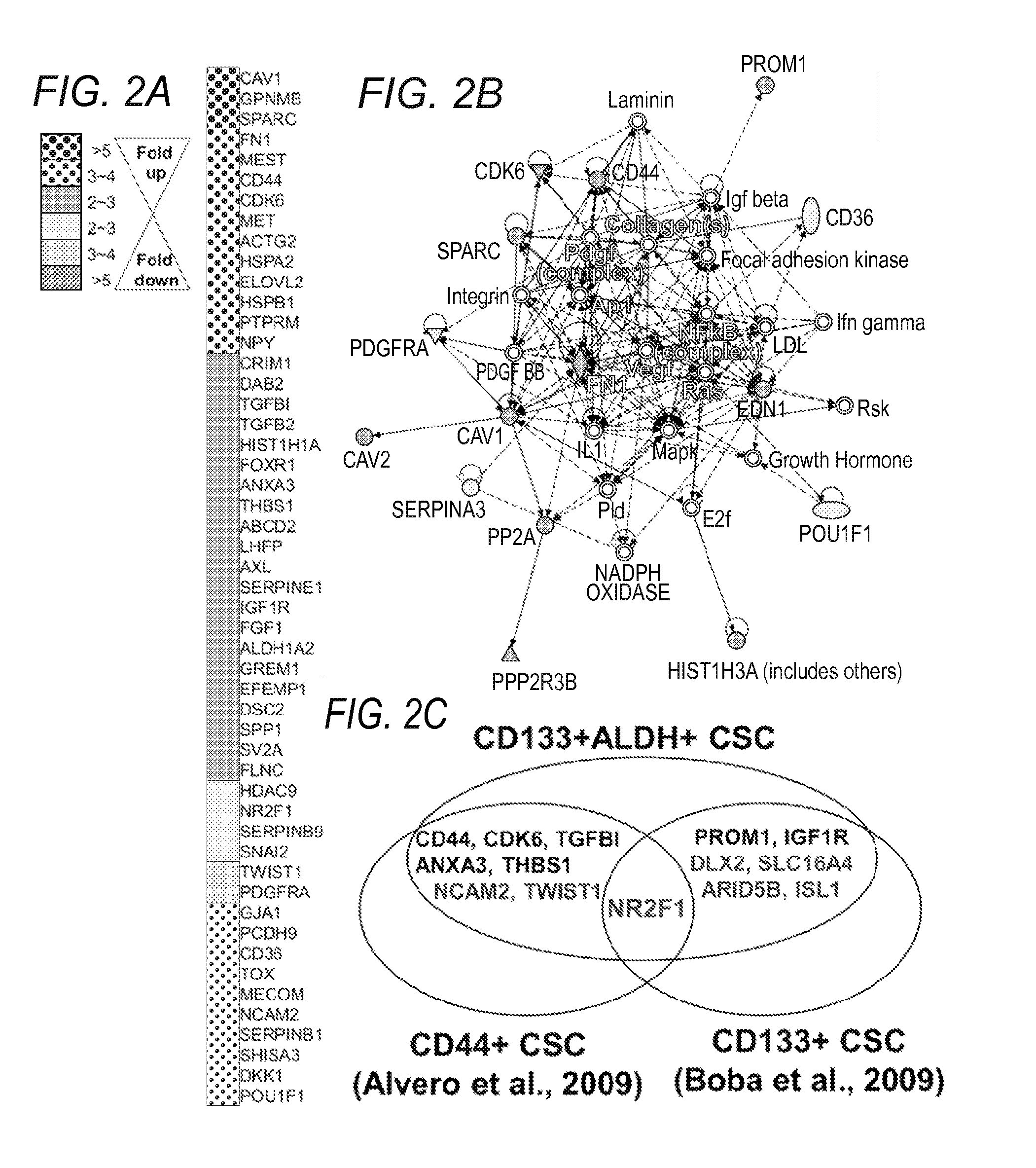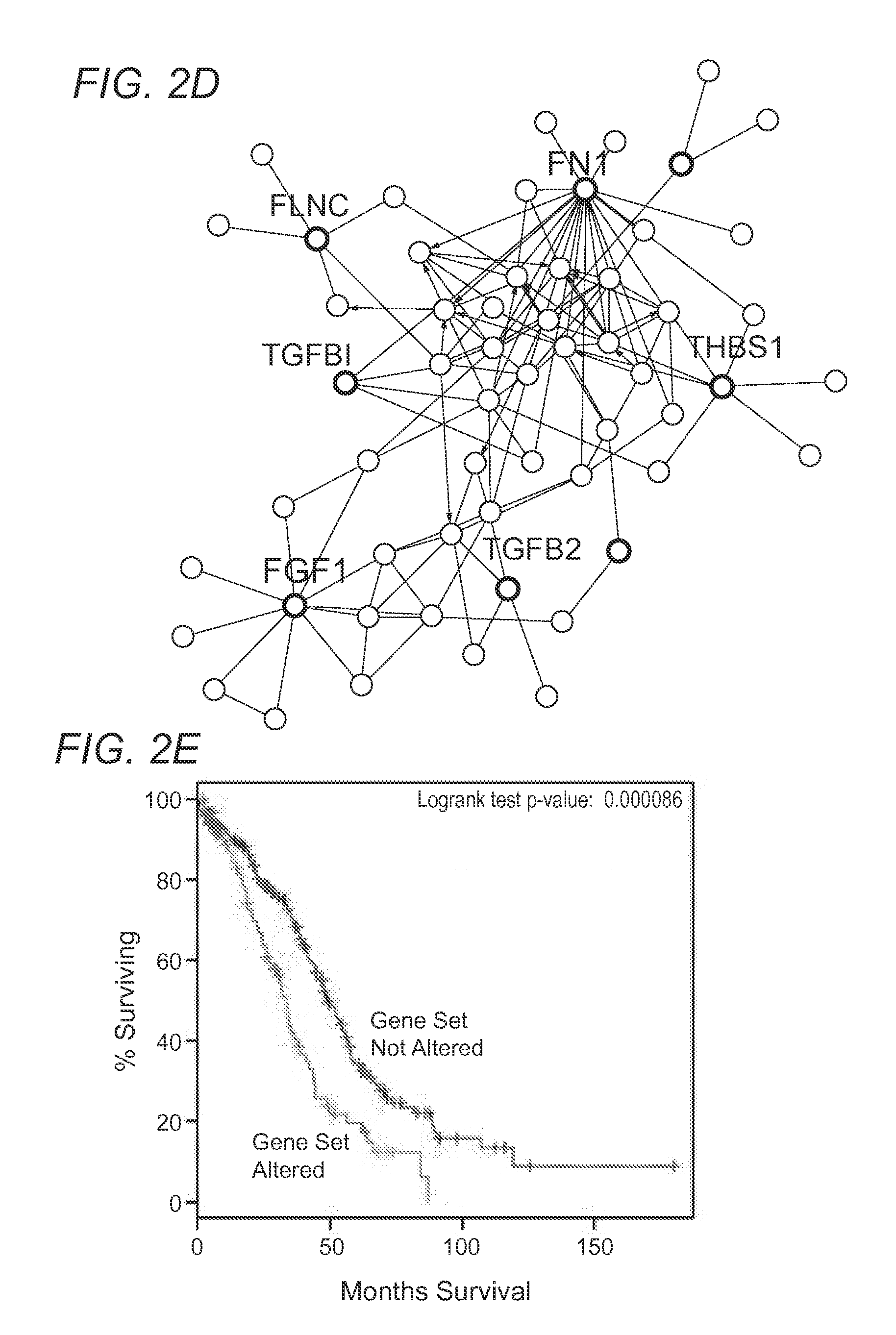Molecular signatures of ovarian cancer
a ovarian cancer and molecular signature technology, applied in the field of gene pathways involved in ovarian cancer growth, can solve the problems of low response rate to other second-line agents, resistance to treatment and subsequently low response rate, and lack of customized strategic approaches for treating these different patient groups, and achieve the effect of optimizing cytoreduction
- Summary
- Abstract
- Description
- Claims
- Application Information
AI Technical Summary
Benefits of technology
Problems solved by technology
Method used
Image
Examples
example 1
Ovarian Cancer Stem Cells (OCSC), Generally
[0102]As described, preliminary studies of cancer stem cells (“CSCs) in the context of ovarian cancer have focused on certain types of cells that appear to be display some or all “stemness” characteristics of CSCs. These are good candidates for bona fide ovarian cancer stem cells (“OCSC”). However, as tumors display morphological, phenotypical, and biochemical heterogeneity, it is understood that different cells may possess only some or many hallmarks of a posited OCSC, yet fail to be a bona fide OCSC. Several leading OCSC candidates include, for example, cells expressing markers CD24, CD44, CD117, CD133 and ALDH1. Among them, CD133 / ALDH1 double markers have been shown most reliable to enrich for OCSC candidates, as further described via morphologhical and functional characteristics, such as spheroid formation, cisplatin resistance, clinical outcome, and perhaps most importantly, tumor formation with as few as 30 cells (i.e., high tumor see...
example 2
Preliminary Identification of Ovarian Cancer Stem Cell (OCSC) Signature from Isolated OCSCs
[0104]The lack of a specific definition for what constitutes a bona fide OCSC is readily understood when considering the lack of a comprehensive study characterizing a core transcriptional program as well as metabolic pathways which OCSCs rely for their survival. Identification of such a critical pathway(s) allows to selective identification and targeting of OCSCs, ultimately improving patients' clinical outcome, through effective prognosis and / or diagnosis of disease subtypes featuring varying populations of OCSC cell numbers, and focused therapy targeting the major culprit, OCSCs, responsible for rapid tumor formation and growth. Toward this goal, the inventors have established a preliminary OCSC signature, which upon validation as a comprehensive global OCSC signature, at the transcript and protein level, provides diagnostic, prognostic and therapeutic guidance to selectively target OCSCs.
[...
example 3
Application of OCSC Signature for Prognostic, Diagnostic, and Therapeutic Guidance
[0110]Interestingly, application of the OCSC as a type of OCSD for prognostic applications indicates that, some biomarkers highly expressed in OCSCs predicted significantly poor patient survival (FIG. 2E), when used in a clinical study dataset (The Cancer Genome Atlas, TCGA dataset, FIG. 2). The inventors further confirmed that OCSC biomarkers, when highly expressed are demonstrated to reduce overall survival in patients when compared to low expression in patients. Specific examples shown include: secreted protein acidic and rich in cysteine (SPARC) (FIG. 3A), aldehyde dehydrogenase 1 family member a2 (ALDH1A2) (FIG. 3B), and desmocolin 2 (DSC2) (FIG. 3C). These results suggest that an OCSC can be applied for prognostic and / or diagnostic use as an OCDS, and demonstrate the advantages of a signature-based detection approach.
[0111]As proof-of-concept, the preliminary identification of an OCSC signature p...
PUM
| Property | Measurement | Unit |
|---|---|---|
| diameter | aaaaa | aaaaa |
| diameter | aaaaa | aaaaa |
| distance | aaaaa | aaaaa |
Abstract
Description
Claims
Application Information
 Login to View More
Login to View More - R&D
- Intellectual Property
- Life Sciences
- Materials
- Tech Scout
- Unparalleled Data Quality
- Higher Quality Content
- 60% Fewer Hallucinations
Browse by: Latest US Patents, China's latest patents, Technical Efficacy Thesaurus, Application Domain, Technology Topic, Popular Technical Reports.
© 2025 PatSnap. All rights reserved.Legal|Privacy policy|Modern Slavery Act Transparency Statement|Sitemap|About US| Contact US: help@patsnap.com



